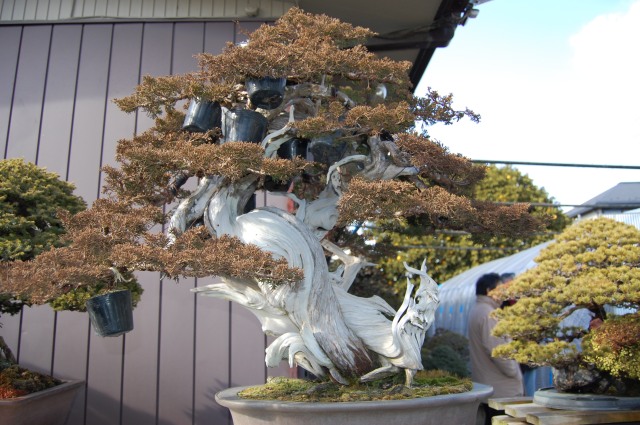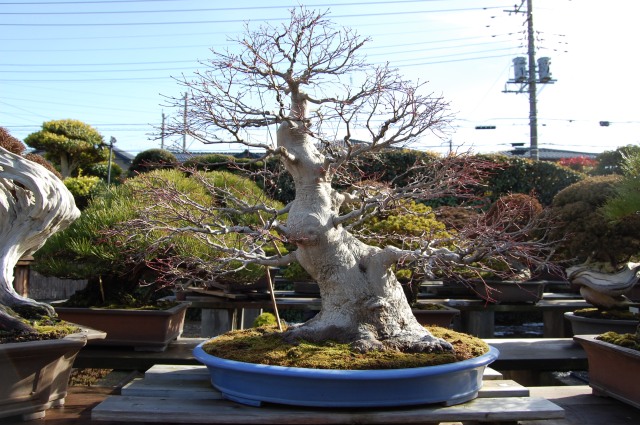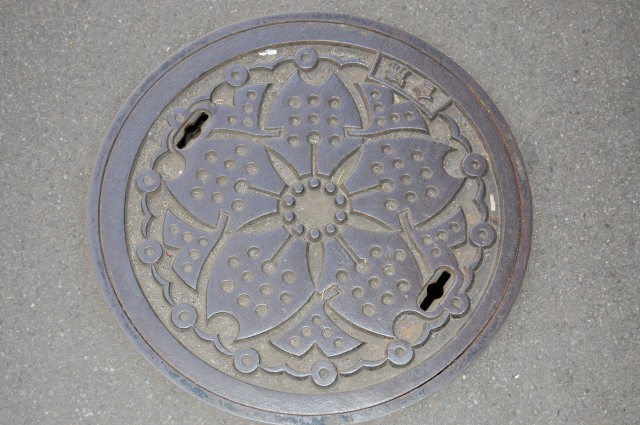The second stop on our garden tour was to Kunio Kobayashi’s bonsai garden, Shunka-en. Located just outside Tokyo (and a fair drive from Kimura’s garden) it was begun by his father some seventy years ago. The garden was the largest I’d seen that day and very impressive. We were greeted by trees before we ever set foot in the garden–they were even on the roof!
Once inside the gate, we were ushered past familiar, famous old junipers and pines to the indoor Tokonoma display area by our guide, whose name I forgot, but has been an apprentice there for two years now and speaks excellent English.
The first display featured an Ume, or Japanese flowering plum, one of the first trees to flower in early spring:
The next display featured a Japanese black pine with a cascading branch and the elements of display suggesting water as the black pine grows close to the shores in Japan:
There were also displays set up between the Tokonomas and here was another Ume:
Our guide explained to us this species lives to around ninety years, which surprised me as they seem much older by the appearance of their bark and hollow trunks. What I appreciate most about them, though, is the contrast of the beautiful flowers and the rugged bark and contorted, bare branches. In the next Tokonoma was another Japanese black pine:
The small accent tree on the right of the display is a ‘chojubai’ Japanese quince; these were frequently used in the Kokufu Show as both main trees and accent plantings. Their bright red flowers set against bare branches impart a similar feeling as the Ume does. We were then led into a small room that had a fire pit built into the floor for tea ceremony:
I think it’s safe to assume a few nice, already burned coals are used as opposed to a roaring bonfire 😉 Another hallway display featured a cascade style white pine. Sorry about the tight shot as there were eleven of us in the group and we had to keep moving along:
This pine was being shown without any training wire, a little unusual for an evergreen but something I saw more of than I expected. In the next Tokonoma was a trident maple root-over-rock twin-trunk style bonsai with a full moon scroll. The moon is often a popular subject for scroll paintings in Japanese display.
I love the level of refinement the branches and twigs have got! And in the next display, a full-size ‘chojubai’ Japanese quince, loaded with blooms; this bonsai was about eighteen or more inches in length.
Our guide went past this display, so I snuck in and got a shot of it anyway. A nice bunjingi style white pine on a stand constructed of bamboo, a rather unusual choice for a stand for a winter display.
That concluded the inside part of the tour and we were led outside again to gather around what we were told was a three thousand year old juniper, a Juniperus chinensis the Japanese call shimpaku. This tree is massive and sits in a suiban that is easily five feet in diameter.
Next, the very fat black pine behind and to the right of this juniper:
Our guide had something to say about this Japanese white pine, which now escapes me. One thing to note about these trees is their size, truly large bonsai. I can appreciate the kind of work that goes into just one tree this size!
After hearing about these large trees, it was time to have tea with Mr. Kobayashi himself! Here he is personally autographing a gift for each of us to take home; what a gracious man. The book was of an exhibit of azalea bonsai, for which Mr. Kobayashi is well known.
Notice the poster for the fourth National Bonsai Exhibition in the U.S. over his right shoulder…I brought a box of chocolates to give as a gift, which he cheerfully accepted and handed off to his wife. There was so much more to see of the garden and the light was fast fading, so I ducked outside again to get a few parting shots.
A large juniper sitting in front of a koi pond; A nice old silverberry or Gumi as it’s called in Japan:
Here I found a black pine under construction; the rebar serving as an anchor to bend some large branches. Everywhere you looked there were bonsai…even up the hill:
The fat old black pine in a different light. And the one to the left:
I’ve got to include at least one azalea!
And a couple of maples tucked away in the corner by some pots that were for sale. This is such a small sampling of what there was to see, if you haven’t been, I hope you will get to see it for yourself. The Australian tour we were with invited us to join them for dinner back in Tokyo, which was the best meal I had the whole trip. Such great experiences have left me with a ‘yen’ for more…and one last image to leave you with from the Green Club sales area the next day:
This was the largest single snow event in Tokyo in forty seven years, according to the news. It sure brought bonsai sales to a halt for a day!






































































































